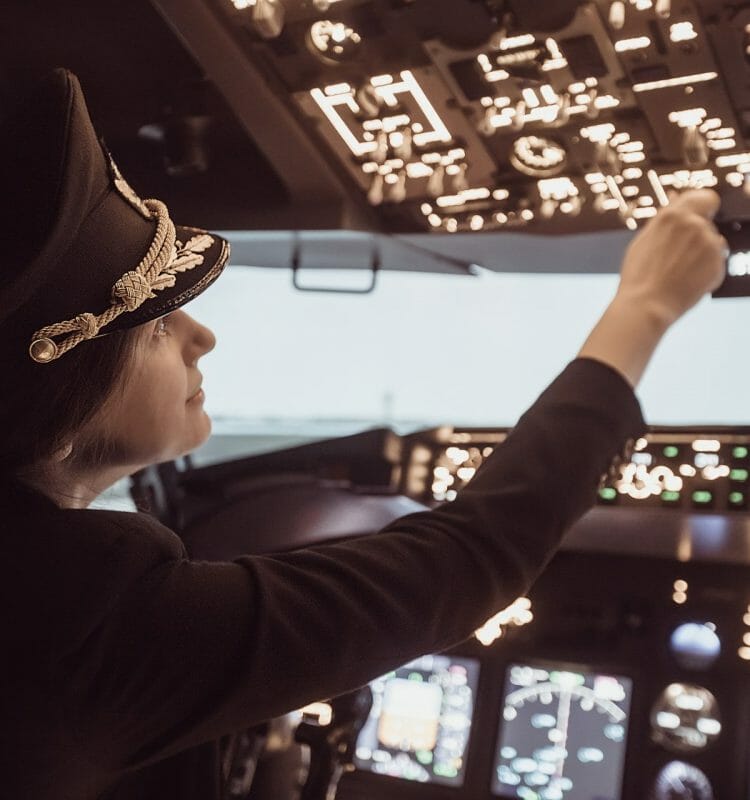EN


Eye tracking technology has the potential to revolutionize the way pilots are trained, as it allows instructors to see exactly what the pilot is focusing on during a flight simulation. By tracking eye movements, instructors can identify which instruments and controls the pilot is paying attention to, as well as any distractions that may be impacting their performance. This information can then be used to provide targeted feedback and coaching to help pilots improve their skills.
In a recent podcast episode, Humanizing Automation: Building Trust and Enhancing Safety through Eye Tracking in Aviation, we interviewed researchers from Smart Eye customer, the Institute of Flight Systems. Researchers Karl Tschurtschenthaler and Simon Schwerd discussed the challenges of human-automation interaction and the potential benefits of cooperative automation in their experience with eye tracking for the aviation use case.
One of the key advantages of eye tracking technology is that it provides objective data that can be used to measure a pilot’s performance. This is particularly important in aviation, where safety is paramount and even small errors can have serious consequences. By using eye tracking data to analyze pilot performance, instructors can identify areas where additional training is needed and develop targeted interventions to address any issues.
Tschurtschenthaler highlighted the importance of understanding the mental state of human operators, such as attention, workload, and situation awareness, in order to design effective cooperative automation systems. He then explains the process flow of adapting to the cognitive state of pilots in aircraft cockpits, which involves measuring dependent variables such as heart rate and using metrics to estimate mental states. The goal of adaptive assistance is to increase the performance of human operators, and the researchers hope to achieve this by developing adaptive assistance and measuring performance increase.
Another benefit of using eye tracking technology in aviation is its potential to improve pilot training. Pilots need to process large amounts of information quickly and accurately, and eye tracking can help trainers understand how they are processing this information. By analyzing a pilot’s eye movements, trainers can identify areas where they may be missing important information or taking too long to process it. This can help trainers develop more effective training methods and help pilots improve their skills.
For example, trainers can use eye tracking technology to monitor a pilot training gaze as they perform specific tasks, such as landing a plane or monitoring instruments. This allows them to see what the pilot is focusing on and for how long. If the pilot is consistently missing important information, the trainer can provide additional guidance and training to help them improve. Similarly, if the pilot is spending too much time looking at a particular instrument, the trainer can help them learn to process this information more quickly.
Another application of eye tracking technology in pilot training is in simulators. Flight simulators are used to train pilots in a safe, controlled environment, but they can be expensive to operate. Eye tracking technology can help trainers identify areas where pilots may be struggling in the simulator, allowing them to focus their attention on these areas during training. This can help pilots improve their performance in the simulator and reduce the amount of time and resources needed to achieve proficiency.
Overall, eye tracking technology has the potential to revolutionize pilot training by providing trainers with a more detailed understanding of how pilots process information. By using this technology to identify areas where pilots may be struggling, trainers can develop more effective training methods and help pilots improve their skills more quickly and efficiently.
Eye tracking technology can also be used to improve the human-machine interaction between pilots and their aircraft. By monitoring the pilot’s eye movements, the aircraft’s control systems can be designed to respond more intuitively and efficiently to the pilot’s intentions. For example, if the pilot is looking at a particular instrument or control panel, the aircraft’s systems can anticipate the pilot’s desired action and adjust accordingly.
Additionally, eye tracking can help to identify areas of the cockpit design that may be causing confusion or frustration for pilots. By analyzing where pilots are looking and for how long, designers can make adjustments to improve the layout and functionality of the cockpit. This can ultimately lead to safer and more efficient flight operations.
In the podcast, both researchers also discussed their work on human adaptive systems in aircraft cockpits, which involves observing and estimating human models to improve automation support. Overall, their research aims to create cooperative automation that mimics human behaviors and improves the performance of human-automation interaction.
Overall, eye tracking technology has the potential to be a game changer in aviation training. By providing objective data on pilot performance and optimizing learning, eye tracking can help to ensure that pilots are fully prepared for any situation they may encounter. As the technology continues to evolve and become more affordable, we can expect to see it increasingly used in aviation training programs around the world. Eye tracking also has the potential to greatly improve the human-machine interaction between pilots and their aircraft. By providing valuable insights into pilot behavior and decision-making, eye tracking can help to enhance pilot training, improve cockpit design, and ultimately lead to safer and more efficient flight operations.
Dive deeper: listen to the full eye tracking in aviation podcast episode here, or if you are interested in eye tracking for aviation applications, contact us to schedule a demo!
